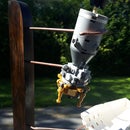Introduction: Custom Leather Sling Style Backpacks and Dog Harness
I spend a lot of time in the woods, and whether I'm taking a bit of a hike or going on an extended camping trip I always bring a backpack. Now for me, standard two strap backpacks are a bit of a pain...literally. I have rheumatic problems in my shoulders that make the contorting in and out of a two strap pack difficult to say the least, and so the simplicity and comfort of a sling style pack is a huge upgrade for me.
This pack design uses 7-8oz chromium tanned leather with 3-4oz veg. tanned leather for the straps and is constructed in a round 'duffel bag' style. I created the entirety of the project using a sewing machine with upholstery thread, however it can just as easily, (and tediously) be done by hand.
The buckles are all hand carved horn and bone with the exception of the dog harness which uses metal. Now, I'll touch on the subject of creating horn buckles, and if there's enough interest in them, I'll create a more detailed instructable later on, however you shouldn't feel obliged to include them in your project. Metal will work just fine.
On the two human packs, the exterior pockets are completely removable so that the pack can be lightened, or if you just need to access its contents without having to deal with carrying the entire pack around.
Initially, I had documented the build on the two green packs, but due to a hard drive crash all of my images were lost. With that, I did have enough leather left to make a third pack and decided that I could create the instructable with ample enough information that anybody could reproduce any of the packs using the techniques applied in the one. In fact, all of the elements that go into creating one pack are exactly the same as the other two. I.E. the dog harness pouches are basically the front pockets of the larger packs. The straps are constructed using the same techniques as well as the stitching, buckles, etc etc.
I won't be including a pattern or template, because by the end of the instructable you won't need one. By applying some of the tricks and techniques you'll have no trouble adapting this instructable to any backpack design you see fit. It's what I like to call 'freebuilding' and it allows for a greater range of personalization, so that when you're done, you can truly call your backpack your own.
Step 1: Tools and Supplies
Tools;
- Sharp utility knife
- ruler
- cutting mat
- leather hole punches
- rivet setting tool
- Sewing Machine with - 14-16 gauge needles in American size or 90-100 in European
- sewing awl
Optional Tools If Making Buckles;
- Dremel with rotary file bits
- Belt sander
- sharp knife
- micro files
Supplies;
- 7-9 oz chromium tanned leather (if using veg tanned for bag, then use 3-4oz)
- 3-4 oz veg tanned leather (dyed or un-dyed)
- Upholstery thread
- leather rivets
- hole grommets
- Buckles (if not making your own)
- horn or deer antler (if making buckles)
Step 2: (Optional) Making Buckles
Creating your own buckles isn't terribly difficult, and if there's interest, I'll create an instructable on it in the future. For starters, you don't need the pin like you do in modern buckles. Traditionally, the strap is woven through the buckles, as per normal, however extra length is left on it so that it wraps around the belt in a half hitch which stops it from slipping. That's why you see in images from the middle ages that they often have the tail of their belts hanging downward.
For starters you need to make a blank by cutting a square out of your horn or antler, then reducing its thickness which can be done using a belt sander. It's smelly work, but you should be wearing a mask anyway as it isn't good to breath organic dust like that. Once your blank is made, you need to cut the slots for the belt. I've carved them using a knife, which requires soaking your horn or antler for at least 24 hours prior, or you can simply use a dremel with rotary file bits. When they are finished sand them with progressively higher and higher grit sandpaper and finish them off with a beeswax polishing. You can find my instructable on beeswax polish here; Natural Beeswax Polish
Step 3: The Body of the Backpack
The body of the backpack consists of four parts, a larger 20"x15" leather piece, a narrow reinforcement 2"x20" strip, a circular 6" piece for the base and a 6"x8" flap. This design is for a smaller backpack which is useful for day tripping or as a general purpose carry. You can increase the size as you see fit.
To do so you'll need to adjust the pieces accordingly, including the circular base. To find the size of the circular base you'll need, take the circumference of the base of the bag and divide by 3.14. This will give you the diameter and an exact size of disk you'll need to cut. For example; width of main body of bag is 20" - 1" for the seam = 19" circumference. 19" / 3.14 = 6.05" You can round down to 6" as the stretch of the leather will compensate for that .05.
Once you have your pieces cut attach your reinforcement strip to the main body. I prefer to do two parallel stitches for strength. Next sew the main body shut. Make certain you're working with the material inside out as you want all of the seams inside the bag and not visible.
It's important to pay attention to where the layers get thicker, such as the seam between the strip and main body. As you fold over to create the master seam, it becomes 4 layers, which can break needles. I highly recommend turning your machine by hand and working slowly over these parts.
Next you can attach your base. You can sew it seam in, or seam out, whatever your preferences. Sewing the seam in will create a rounded base while seam out will give it a base that kind of resembles a propane tank. I've done both before, however this bag design incorporates seam in.
Now with your bag inside out, you need to sew a 1" lip around the top of the bag. This will reinforce the opening and give you a place to mount your drawstring grommets.
Finally you need to attach the flap. It should mount roughly 2" down from the top lip and perfectly centered on where you've designated as the back of the bag. You don't need to make the main seam the back of the bag. It can sit on the side, or even the front. It all boils down to design choice.
Step 4: Creating the Pouch
The pouch consists of a 6"x12" main body, two sides pieces that are 3"x4.5" and a flap which is 4"x6". For this piece, it's best to sew it seam out, for aesthetics.
First you need to attach the flap to the main body. It only needs to be single seamed and mounted with a 1/2" overlap. Next, starting at the opposite end of the flap begin attaching your sides. When you get to where it rounds, I recommend turning the sewing machine by hand. Keep readjusting the seam by lifting the foot, pulling the edges together then lowering it to hold it in place. Make sure you needle is down through the material before raising the foot.
When your first side is in place, you'll need to assess where you'll be mounting the buckle. (Details on buckle setup will be addressed later on in the instructable). The buckle is riveted to the pouch with an extended leather strap hanging down from the pouch. This strap extension will be used to secure the pouch to the pack via a second buckle riveted directly to the pack body, so it's best to make the closing buckle and mounting strap all one piece.
Finally, a strap is attached to the flap of the pouch. I recommend a double rivet to keep the strap from shifting around and eventually working loose.
Step 5: The Shoulder Strap
The shoulder strap is created using a 2"x24" piece of 3-4oz veg tan leather with a same sized piece of 7-9oz chromium tanned leather glued and sewn to it to act as padding for the strap. There is a smaller 1.125"x18" strap for buckle end that is woven through punched and cut slots in the main strap.
It's important that the edges of the straps be sewn for additional strength. Many people overlook this step and end up with straps that are stretched and even broken from wear. Many folks would call it optional, but I think it's a mandatory step and goes a long way toward quality of workmanship.
For the main strap, cut your length, then attach your chromium tanned piece to the underside using leather glue, and trim off any excess. Once it dries, sew a seam around the entire edge of the strap to keep it permanently together.
Once your strap is made you'll need to create the guides to hold your buckle strap in place. Measure out two positions, at one end of your strap 6" apart. The guides should be a minimum of 1" thick and extend 1/8" on each side of your buckle strap so that it slides in smoothly, but snugly. Now punch your holes in the four corners of your guide and using a utility knife with a ruler, slice the leather between them being careful not to cut beyond your punched holes.
Now feed your buckle strap through and set it into place at least 2" above the uppermost guide and punch a hole through all three layers to fasten a rivet. You can double it up however 1 rivet will be more than enough to hold it together.
Put your strap aside for now.
Step 6: Creating the Buckles
For this project I'm using a combination of horn and antler to create the buckle system, with antler tip toggles for bag closers. The straps are created using 3-4oz veg tanned leather that's riveted around the center post on the buckles. No pins are needed to keep the buckles closed as they are friction based fasteners. I do, however, leave some length on the end of the straps for the traditional half hitch because as they wear, they will become looser.
The toggles are created by punching and cutting a 1.5" slot in the leather strip, then feeding it through a hole drilled in the center of the toggle and wrapping it down and around the antler tip. The straps are created in much the same way. I'll explain further in the next step when I cover mounting your fastening hardware to the bag.
Step 7: Mounting the Pouch to the Bag and Closing Hardware
The pouch is held to the bag using a simple buckle system. The tail end of the closer buckle, on the pouch is used to hold it in place by feeding through a second buckle that's mounted to the bottom center of the pack. A second buckle and strap are mounted on either side of the pouch and and fasten under the closer buckle. This allows the pouch to be removed from the bag for easy access but also be held securely in place when attached.
**Note** When mounting your hardware you can either sew it into place or use rivets. If you use rivets, I recommend adding a leather 'washer' to the inside to thicken the material and make it more secure. This will go a long way to prevent the rivets being torn loose when you're walking through the woods and your pocket gets snagged on a branch.
The closing hardware is created by riveting the toggles to the body of the pack, and the straps to the flap of the bag. When deciding where to mount them, I recommend stuffing your bag full of newsprint, then closing the flap to see how it sits and marking positions. This will ensure that your bag will still be able to close when filled.
Step 8: The Closing Drawstring
The drawstring is made using six hole grommets placed two in the back, two on the sides and two in the front. A 1/4" strand is cut from the 3-4oz leather which is fed through the grommets with the tail ends exiting the front two. The ends are knotted and a 'bow tie' is created to secure them together.
The bow tie is made by cutting a a 3" strip. Then three holes are punched with one at each end and a third in the center. The ends are folded, lining up the holes and a rivet is set to hold it together.
Step 9: Mounting the Shoulder Strap
The shoulder strap can be mounted directly to the bag, or a padded shoulder rest can be added for extra comfort. The padded shoulder rest is simply an isosceles triangle shape with the extended point cut off. Overall measurements before stitching are roughly 8" wide at the bag attachment point, length of 10" long and 4.5" where the strap mounts in place. The edges are folded in to the center and overlapped and the end of the shoulder strap is secured inside with stitching, rivets or both. A line of stitching is sewn down the overlap to keep the strap closed and secure it from stretching.
**note** When mounting the shoulder strap to the bag, I highly recommend stitching as well as riveting for extra strength.
The buckle at the base of the shoulder strap is mounted off edge of the bag, and not directly to its center as in image #2. First you need to decide which side of your body you want the strap to cross. For this bag, I wanted the top of the bag to be on the right side, with the strap crossing from top right to bottom left, which means that the buckle needed to extend out the left side of the bag (when looking at it from the pocket, flap side). When looking at the part of the bag that sits against your back, it would be the right.
Now, four holes are punched into the strap. Two at the end that meets the center of the back, and two near the end of the buckle. Leave at least 2" play from the rivets to the buckle for free movement. Now, the buckle/strap is placed over the bottom of the bag and the hole positions are marked. The holes are punched through the bag and rivets are used to secure the buckle in place. Again, you can stitch it, but with a four rivet system, you shouldn't need to provided you used the leather washers that were used on the pouch mounting hardware.
Finally, weave your 1.125" strap through the buckle and secure it with a half hitch, as in picture #3.
Step 10: Finished (Added Design)
That's it. All of the design specs that went into the creation of this bag can be incorporated into a bag style of your choosing with only minor adjustments. This leather bag is durable, water proof and very comfortable to wear and should last you a very long time as you're trekking through the woods, or simply making the trek to school.
As requested I've added a couple of images that detail the design of the dog pack. I sincerely hope they're clear enough as I am terrible at transposing the designs in my mind on paper. If you have any questions feel free to ask.
As usual, I hope you enjoyed the instructable and thanks for following.

Finalist in the
Leather Goods Contest

Participated in the
Wear It! Contest













